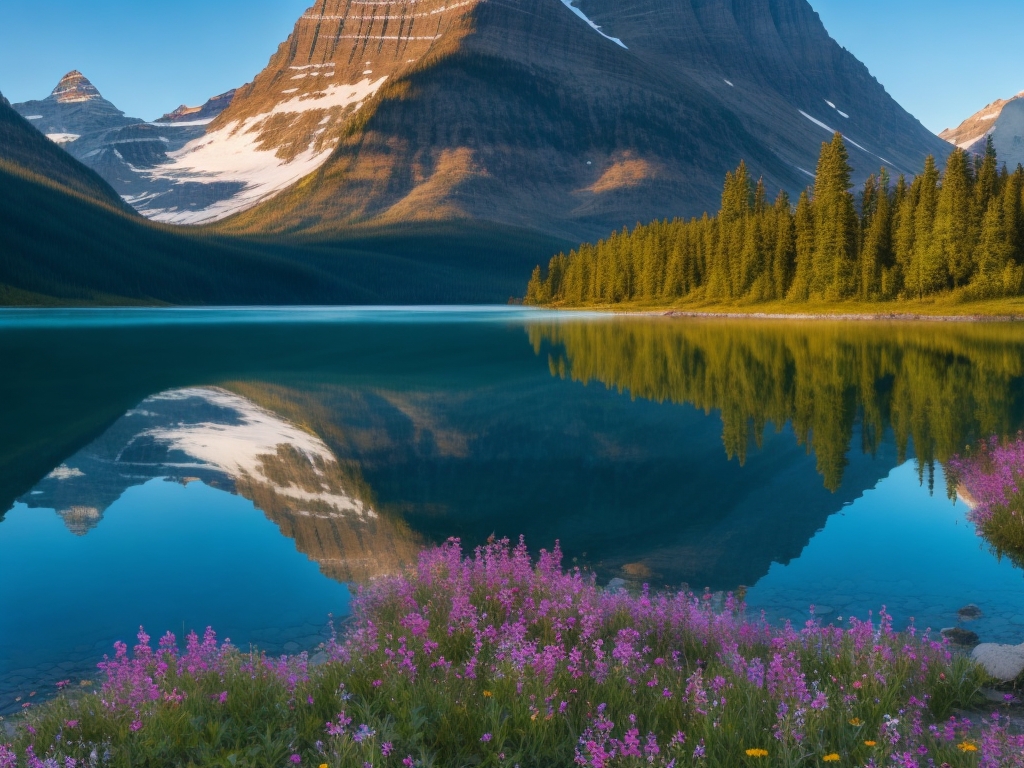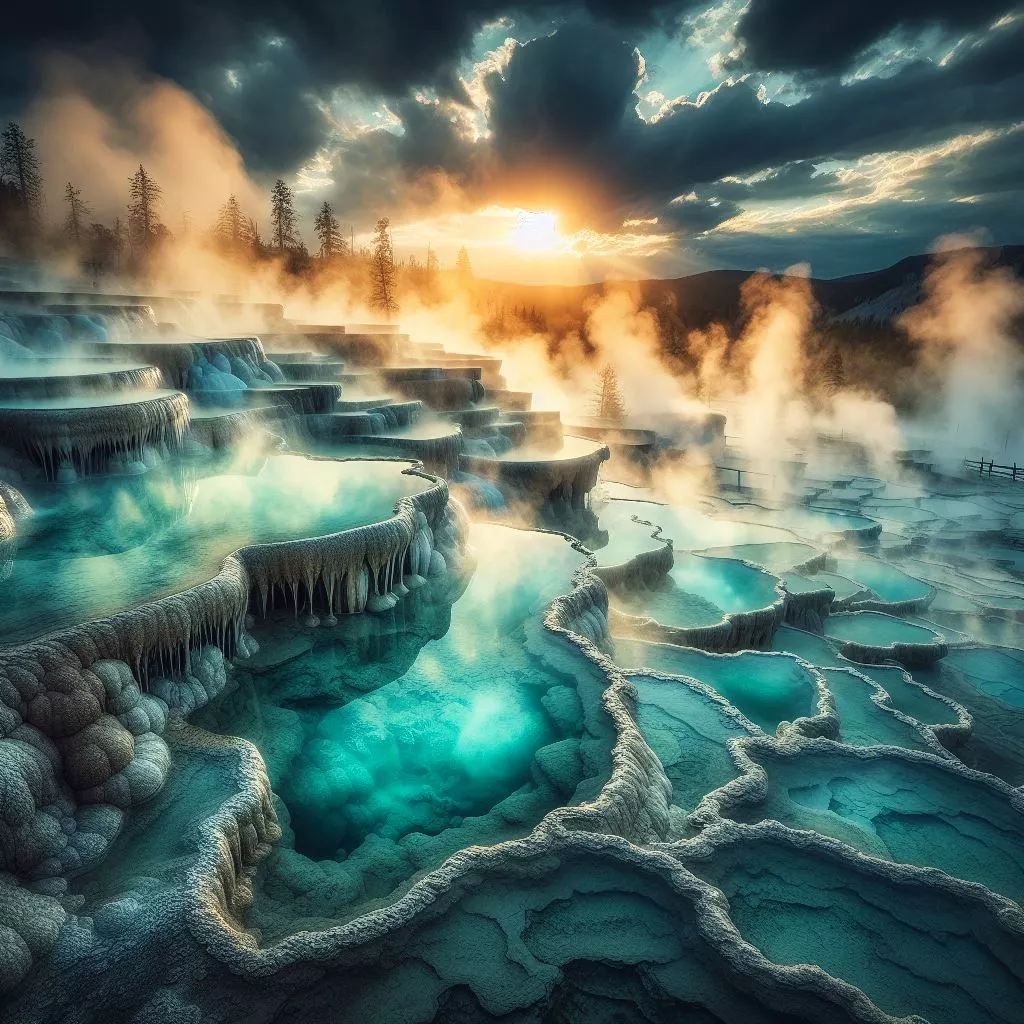Are you ready to embark on an exciting journey through the magnificent wonders of Yellowstone?
Get ready to be amazed by the Yellowstone volcano fun facts that will leave you in awe!
From the geological formation of this stunning national park to the explosive history of its mighty volcano, there’s so much to discover.
So, grab your sense of adventure and join us as we delve into the unique geothermal features and the remarkable influence that Yellowstone has on its surrounding landscape.
Let’s dive into this extraordinary world together!
Key Takeaways
- Yellowstone National Park is home to one of the largest volcanic calderas in the world.
- The park’s unique geothermal features include hot springs, mud pots, and geysers.
- Yellowstone’s wildlife and ecosystem play vital roles in maintaining ecological balance.
- While volcanic activity has shaped the landscape and created unique habitats, it also poses a significant threat to the park’s ecosystem and wildlife.
The Geological Formation of Yellowstone National Park
The geological formation of Yellowstone National Park is a result of millions of years of volcanic activity. Picture this: imagine the Earth’s inner forces at work, shaping and molding the landscape over time. Countless geological processes have been at play, from lava flows to ash deposits.
As the formation timeline unfolded, layers upon layers were added, creating a unique tapestry of rock formations and geothermal wonders.
Now, let’s delve into the massive size of the Yellowstone Caldera and its awe-inspiring features.
The Massive Size of the Yellowstone Caldera
Covering an area of 1,500 square miles, the Yellowstone Caldera is one of the largest volcanic calderas in the world.
Imagine standing at its edge, feeling small and insignificant compared to its immense size. As you gaze out, you can’t help but marvel at the scale of this natural wonder. It dwarfs cities and mountains alike, reminding us of the incredible power that lies dormant beneath our feet.
But don’t be fooled by its seemingly peaceful appearance; beneath the surface lies a history of explosive volcanic activity that has shaped this majestic landscape for millions of years.
The Explosive History of the Yellowstone Volcano
Imagine standing at the edge of the massive Yellowstone Caldera, feeling the ground tremble beneath your feet as you contemplate its explosive history.
This incredible volcano has a long and turbulent past, marked by countless explosive eruptions that have shaped the landscape around you. These eruptions released vast amounts of volcanic ash, which settled and formed layers upon layers of volcanic ash deposition over millions of years.
Now let’s dive deeper into the fascinating world of the Yellowstone supervolcano: fact or fiction?
The Yellowstone Supervolcano: Fact or Fiction?
You might be wondering if the Yellowstone supervolcano is real or just a fictional creation. Well, let me assure you, it’s very real indeed.
Scientific research has confirmed its existence and potential dangers. This massive volcano has been studied extensively, revealing its immense power and the catastrophic consequences it could bring.
But fear not, for understanding these dangers allows us to better appreciate and protect the unique geothermal features of Yellowstone that we will explore next.
The Unique Geothermal Features of Yellowstone
The geothermal features at Yellowstone are truly remarkable. Hot springs, mud pots, and geysers are scattered throughout the park. As you explore this natural wonderland, you can’t help but marvel at the potential for geothermal energy utilization and the thriving hot springs tourism industry.
The vibrant colors and bubbling cauldrons create a sense of awe and belonging as you witness nature’s power firsthand. But amidst all these wonders lies the famous Old Faithful geyser. It is ready to captivate you with its predictable eruptions.
The Famous Old Faithful Geyser
Step into the world of Yellowstone’s geothermal wonders and let yourself be captivated by the mesmerizing Old Faithful Geyser. This iconic hydrothermal feature is renowned for its regular eruptions, which follow a predictable pattern that has fascinated visitors for decades.
As you stand in awe, imagine the power beneath your feet, waiting to burst forth in a magnificent display of nature’s force.
But Old Faithful is just one of many incredible sights awaiting you at Yellowstone…
The Yellowstone Hot Springs and Mud Pots
Exploring Yellowstone’s geothermal wonders is like embarking on a journey through nature’s own hot springs and bubbling mud pots. These unique geothermal wonders are not only visually captivating but also home to a hidden world of microbial life.
As you witness the vibrant colors and feel the warmth emanating from Yellowstone’s hot springs, you can’t help but feel a sense of belonging to this extraordinary ecosystem.
Now, let’s delve into the enchanting world of Yellowstone’s wildlife and ecosystem.
The Yellowstone Wildlife and Ecosystem
Witnessing the diversity of wildlife and experiencing the intricate ecosystem in Yellowstone is truly awe-inspiring. The park’s commitment to wildlife conservation and maintaining ecological balance ensures a harmonious coexistence between animals, plants, and their habitats. Take a moment to explore the table below, showcasing some of the incredible creatures that call this national park home. From majestic wolves to adorable otters, each species plays a vital role in preserving the delicate equilibrium of this remarkable ecosystem.
| Species | Role in Ecosystem |
|---|---|
| Gray Wolf | Keystone predator |
| American Bison | Ecosystem engineer |
| Grizzly Bear | Seed disperser |
| River Otter | Indicator species |
| Bald Eagle | Top predator |
Now that you’ve glimpsed into the thriving wildlife of Yellowstone, let’s delve deeper into understanding how volcanic activity impacts the biodiversity of this extraordinary place.
The Impact of Volcanic Activity on the Park’s Biodiversity
As you delve deeper into the impact of volcanic activity on the biodiversity of this extraordinary park, you’ll discover how eruptions and lava flows shape the landscape and create unique habitats for a variety of species.
Imagine vibrant wildflowers blooming amidst blackened lava fields.
Picture resilient animals adapting to survive in harsh, newly formed environments.
Visualize lush forests emerging from the ashes, showcasing nature’s remarkable ability to recover and thrive after volcanic eruptions.
Now, let’s explore the potential threat of future eruptions in Yellowstone National Park.
The Potential Threat of Future Eruptions
Future eruptions in Yellowstone National Park could pose a significant threat to the surrounding ecosystem and wildlife. The potential for destruction is immense, but there are ways to mitigate this risk.
Volcanic hazard assessments can help identify areas of vulnerability and inform decision-making processes. By implementing effective mitigation strategies, such as land-use planning and early warning systems, we can minimize the impact of future eruptions on Yellowstone’s precious biodiversity.
Now let’s explore the monitoring and research efforts at Yellowstone that aim to safeguard this unique ecosystem.
The Monitoring and Research Efforts at Yellowstone
Explore the ongoing monitoring and research efforts at Yellowstone, which aim to ensure the safety and preservation of its unique ecosystem.
Discover how scientists are using innovative techniques to monitor the volcano’s activity and gather valuable data.
Uncover fascinating research findings that shed light on the complex geological processes happening beneath the surface.
Join a community of passionate individuals dedicated to protecting this natural wonder, as we delve into the Yellowstone volcano’s influence on the surrounding landscape.
The Yellowstone Volcano’s Influence on the Surrounding Landscape
Discover how the unique geological processes beneath the surface of Yellowstone have shaped the surrounding landscape.
The power and influence of the Yellowstone Volcano are immense, not only in terms of its impact on geothermal activity but also its effect on local fauna.
The volcanic activity has created a dynamic environment that supports a wide range of species, from thermal-loving bacteria to iconic wildlife like grizzly bears and wolves.
Understanding these connections between geology and biology is crucial in unraveling the mysteries of Yellowstone’s formation over millions of years.
The Geologic Time Scale of Yellowstone’s Formation
As you marvel at the breathtaking landscape shaped by the mighty Yellowstone Volcano, let’s delve into the geologic time scale of its formation.
Picture this: a table that unravels the mysteries of time, revealing the intricate layers of rock and sediment. Imagine columns representing epochs and rows capturing stages in the volcano’s evolution. This visual aid paints a vivid picture of Yellowstone’s formation process, taking you on an awe-inspiring journey through millions of years.
And now, let’s explore the geological significance of Yellowstone National Park…
The Geological Significance of Yellowstone National Park
Imagine standing on the edge of a massive caldera, surrounded by colorful hot springs and powerful geysers that showcase the geological significance of Yellowstone National Park.
The constant bubbling and erupting reveal the ongoing geological activity within this natural wonder. Witnessing these mesmerizing displays, you feel connected to something greater than yourself, a part of the ever-changing landscape shaped by intense geological processes.
This reminder of our planet’s dynamic nature underscores the importance of preserving and protecting Yellowstone for future generations to experience its awe-inspiring beauty.
The Importance of Preserving and Protecting Yellowstone
Take a moment to reflect on the crucial role you play in safeguarding the unparalleled natural beauty and ecological significance of Yellowstone National Park.
1) Conservation is key: By preserving Yellowstone, you are ensuring future generations can experience its wonders.
2) Ecological balance matters: Protecting the park’s diverse habitats allows for thriving wildlife populations and a healthy ecosystem.
3) Be a steward of nature: Your actions have the power to make a lasting impact on this remarkable place.
Together, we can preserve Yellowstone’s legacy for years to come.
Frequently Asked Questions
How many eruptions has the Yellowstone Volcano had in its history?
The Yellowstone volcano has experienced a fascinating history of eruptions. Over time, it has erupted numerous times, showcasing its unique eruption patterns and contributing to its rich geological history.
What is the largest eruption that has occurred at Yellowstone?
The largest eruption at Yellowstone was the Lava Creek eruption, which occurred about 640,000 years ago. It was one of the most powerful eruptions in Earth’s history and is part of the Yellowstone eruption timeline. This eruption caused widespread devastation and unleashed volcanic hazards on a massive scale.
Can volcanic activity at Yellowstone affect the weather in surrounding areas?
Volcanic activity at Yellowstone can have a significant impact on weather patterns in the surrounding areas. The eruption can release ash and gases into the atmosphere, altering atmospheric conditions and potentially causing changes in temperature, precipitation, and wind patterns.
Are there any active volcanoes within Yellowstone National Park?
Yes, there is an active volcano within Yellowstone National Park called the Yellowstone Caldera. Its volcanic activity has shaped the stunning landscape and continues to contribute to the park’s unique natural wonders.
How often is the Yellowstone Caldera monitored for signs of volcanic activity?
Yellowstone caldera is closely monitored for signs of volcanic activity using advanced technology. Scientists monitor it regularly to ensure the safety of visitors and residents. With the help of technological advancements, monitoring frequency has significantly increased, allowing for early detection and timely response to any potential volcanic activity.
Conclusion
Congratulations! You’ve just embarked on an extraordinary journey through the captivating world of Yellowstone National Park.
From the geological wonders that shaped this majestic landscape to the explosive history of its volcano, you’ve delved into a realm of awe-inspiring beauty and scientific marvels.
As you reflect on your adventure, remember the crucial importance of preserving and protecting this unique ecosystem for future generations to explore and cherish.
So go forth, be visionary, and let your imagination soar as you continue to unravel the mysteries of our incredible planet.




